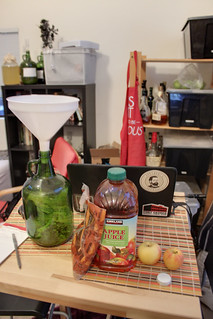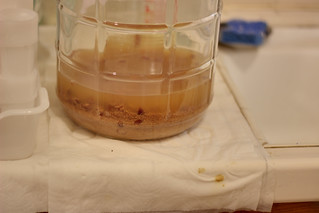Batch 018: Floats in Water
This is our first wild-fermented cider, based roughly on Paul Correnty's Tim's Firehouse Cider
recipe on page 51 of The Art of Cidermaking. We're calling this batch Floats in Water, after a joke about cider in Monty Python and the Holy Grail.
Ingredients in this batch

- 1 cup dark brown sugar.
- 1 gallon, 15 cups, 1 oz. Kirkland fresh apple juice.
- ½ tsp. each of Valley Brewers yeast nutrient and yeast energizer.
- 1 tsp. ground Chinese cinnamon from Penzeys Spices.
- skin, peeled, from 2 small, unwashed gala apples, for yeast.
- 8 oz. dried cranberries (added on 14 August).
- 8 oz. date nuggets (added on 14 August).
- 2 cups of dark brown sugar (added on 1 September).
- 1 gal. Perricone Farms apple juice (added on 12 November).
- 1 cup close-packed dark brown sugar (added on 12 November).
- ¾ tsp. LD Carlson pectic enzyme (added on 12 January 2017).
- ½ tsp. malic acid (added on 22 January 2017).
Poured the brown sugar, yeast nutrient, yeast energizer, and cinnamon into a four-liter carboy, then poured in one gallon of the apple juice. Peeled the gala apples, then dropped the peels in for wild yeast (fingers crossed). Popped in an airlock and filled it with vodka.
Waited several days for the wild fermentation to start, then, just as I was trying to decide what yeast I was going to pitch in, carbon dioxide production started on 14 August. At that time, racked half the fermenting juice into another four-liter carboy, put four ounces of dates and four ounces of cranberries into each of the carboys, and topped them off with all but seven ounces of another gallon of the same apple juice. Then I placed a fermentation lock on each carboy and labeled the second carboy Batch #018B
, which may or may not have homogenized enough over the previous few days to be more or less identical to the original half of Batch 18.
On 12 November, poured both gallons, along with all of the fruit and yeast, into a sanitized new three-gallon carboy, then added another cup of brown sugar and another gallon of apple juice, then stirred vigorously to oxygenate in the hopes of restarting fermentation. Took gravity readings before and after the addition of new juice and sugar.
Brew date: 9 August 2016.
Original gravity: 1.052. (Due to additional sugars added, treating this batch as if the O.G. were 1.092.)
Estimated ABV: approx. 12.5%.
Yield:
- 13 x 12 oz. beer bottles
- 2 x 22 oz. beer bottles
- 1 x hydrometer tube
Total yield: Approx 205 oz., or about 1.6 gallons. (Wow, we lost almost half of this batch to multiple rackings due to that incredibly woolly wild yeast.)

Notes and observations
- 2016-08-10T11:17:00: No evidence of fermentation.
- 2016-08-14T11:44:00: No evidence of fermentation.
- 2016-08-14T20:12:00: There is clearly fermentation in the carboy! Split into two batches (#018B does not contain apple peel, and may not be homogeneous with the first carboy, though I doubt it's far off. The fermenting cider smells delicious.)
- 2016-08-15T10:11: Both carboys are clearly fermenting rather vigorously.
- 2016-09-01: Added one cup of dark brown sugar to each of the two carboys and took hydrometer readings. Batch 018a has a current gravity of 0.995; batch 018b has a current gravity of 0.997. Lackadaisical fermentation started again almost immediately, but fell off by morning.
- 2016-11-12: Poured both gallons of cider into a sterilized 3-gallon carboy, then added another gallon of juice and another cup of brown sugar. Stirred vigorously to aerate in the hope of restarting fermentation. Gravity of the combined must before the addition of new juice and sugar was 0.999; gravity after the addition of sugar and juice was 1.023. Poured the fermented cider from a height, agitated the new unfermented cider before adding it, and then stirred vigorously in the carboy for several minutes, in an attempt to aerate. The fermenting must has dropped out a huge amount of yeast, and the juice is brown (oxygenation? side effect of wild yeast? lots of dark-brown sugar?), but it smells quite good and and tastes tart and sweet; I think it may turn out well (fingers crossed). I may want to add some tannin to this one.
- 2016-12-04: Racked the cider off of the incredibly woolly lees of its wild yeast, into a sanitized bucket; then, I dumped out the yeast, berries, and other crap from the bottom of the three-gallon carboy and cleaned and sanitized it, and racked the cider back into it. Gravity at this point is 1.000. Wow, that really was a lot of woolly yeast. Kind of amazing.
- 2017-01-13T00:47: The cider is still opaque, so I added some pectic enzyme in the hope that this will help clarify the cider.
- 2017-01-22T16:48: Added some malic acid: the cider is kind of bland.
- 2017-02-08: Racked into two 4-liter green-glass carboys and popped in undrilled stoppers in preparation for cold-crashing. Set in the cooler with what remained of the ice used to cold-crash batchs 036 and 037, which had previously been cold-crashing.
- 2017-02-12: Finally dropped fourteen pounds of ice over the two green carboys. They had been sitting in the cooler in the melt-water left over from crashing batches 036 and 037.
- 2017-02-16: Bottled, yielding approx 1.6 gallons. Figuring ABV based on a number of assumptions (that 8 oz. of date nuggets contain 160 g of sugar; that 8 oz of dried cranberries contain about 150 g of sugar; that all the apple juice contains the same amount of sugar; that all told, the sugar additions come to the equivalent of .85 cups of sugar per gallon). This results in an as-if O.G. of 1.092, and therefore an estimated ABV of about 12.5%.